19 best content optimization tools for 2026
When you Google (or ask ChatGPT) for content optimization tools, you’ll get a list of search engine optimization (SEO) tools instead. Some well-known and market-leading tools include Clearscope, Marketmuse, and Semrush.
While I’m not here to argue with Google, SEO provides a narrow view of content optimization.
Optimizing your content and website for search engines certainly helps you drive more traffic, but keeping visitors engaged with your content and later converting visitors to profitable customers are far more important metrics. An increase in any website’s traffic is only meaningful if you can keep the other two metrics, engagement and conversion rates, at a healthy level.
Those key revenue-generating metrics can’t be improved much with SEO tools. You’ll need more instruments in your content optimization toolkit, such as analytics, website personalization, and AI writing tools, to capture a busy customer’s attention.
This blog post aims to provide you with a much more comprehensive range of content optimization tools and techniques – without forgetting the good ol’ SEO!
SEO tools for content optimization

SEO tools are the foundation of content optimization techniques. After all, if you don’t have search engine optimized pages, you’ll need to pay big money to get noticed and introduce your services to new audiences.
There’s an abundance of blog posts listing the best content optimization tools for SEO, but I’ll introduce you to some of the most interesting ones.
My favourite tools for technical SEO analysis and competitor comparisons are Semrush and Ahrefs. They are essential for every content optimization project, ensuring you maintain the momentum with your current top-ranking pages, find new opportunities, and discover content gaps against competitors. Whether you are just starting your company’s SEO project or a seasoned specialist, you’ll need one of those in your toolkit.
After researching and getting started with content creation, services like Clearscope become your best buddies by giving you a search engine optimization score, suggesting keywords and improvements, and analyzing the readability. I also like to run every text through Grammarly to make sure my readers do not notice as quickly that I’m not a native English speaker.
If you already have an active blog and are unsure whether the content is optimized, Dashword’s content optimization checker gives you an idea of the competition and areas for improvement.
Analytics tools for content optimization

Now, analytics tools come in two different formats:
- The raw analytics data tools
- Content insights tools
A great example of raw analytics data are the number of website visits and visitors, time spent on the site, and similar core metrics in Google Analytics. While the most important metrics give you an idea of how the page performs, they often fail to explain the WHY.
For example, just by looking at the data in Google Analytics, you might think certain content is not performing well due to low time spent on the page. However, if you use website optimization tools like CrazyEgg and review the page heatmap, you often discover that users are exiting via an internal link or CTA button. Perhaps your SaaS landing page is executing its task perfectly, but the next step in the journey fails to deliver and convert visitors to customers.
To address the same challenge and help you explain the why, a content optimization tool ContentSquare aims to quantify the dollar value of each element – and also the negative value of page errors. Instead of looking at the page purely from SEO and look & feel perspective, ContentSquare can reveal elements that convert visitors to customers. They provide collaborative tools for website and content optimization teams to understand better the page and content performance beyond the raw analytics.

Finally, visualizing the data often helps you discover insights you didn’t know existed and makes your analytics actionable. Data management platforms like Mammoth allow you to aggregate, enrich, and combine analytics data from multiple sources and create visual dashboards.
Tools like Narrative BI translate your content analytics and metrics into engaging stories and visualizations – stories typically help you to get the message across faster inside your organization, securing the well-needed budget for your content optimization project.

Website personalization tools for content optimization
So far, we’ve discussed optimization tools that help you increase the traffic volume and discover insights from a large number of signals.
But we are all unique web browsers, and when complying with the data privacy regulations, the website experience should match our unique characteristics as well.
The perfect match is called content personalization.
One of my favourite website personalization tools is RightMessage, which allows marketers to personalize content based on the customer segment and the traffic source. For example, you might use dynamic landing pages to change the title depending on the previously visited page (traffic funnel) or an advert the user clicked.
Platforms like Nosto, a personalization engine for e-commerce sites, help webshops create unique shopping experiences by recommending products based on user behaviour. Gone are the days when the “You might also like this” element was the same for every website visitor.

With tools like Optimizely, large brands can build websites, run A/B tests, and dynamically optimize the content experience for different customer segments.
AI tools for content optimization
AI image generators and similar tools for content generation are the most prominent area of the recent AI development. More than 10 million customers have signed up for Copy.ai, one of the first AI writing tools, helping anyone to generate high-quality content faster.
While AI is not replacing the strategic work just yet, it’s making content optimization much faster and more efficient.
For example, Photoroom helps you effortlessly change the image background or place your product photos in a completely new environment. An e-commerce site with manufacturer’s stock photos can now transform generic visuals into branded and engaging images with a few clicks.
LandingRabbit helps SaaS marketers create high-converting landing pages and launch them on their existing website in minutes – instead of days.
Platforms like Speechify use AI to dub your videos in multiple languages. Tools like BeyondWords help you convert text to speech at scale, optimizing your content for various audiences and making your site more accessible.
Summary: What is the best tool for optimization?
As discussed in this blog post, there’s no single tool to tackle your complete content optimization needs. To ensure you’ve got a holistic view of the website visitor and you can continuously improve your website and user experience, you’ll need much more than a single SEO tool.